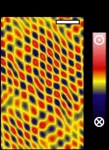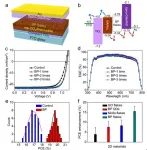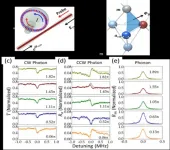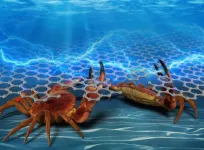Search for strange Skyrmion phenomenon fails but finds stranger magnetic beaded necklace
Physicists on the hunt for a rarely seen magnetic spin texture have discovered another object that bears its hallmarks, hidden in the structure of ultra-thin magnetic films, that they have called an incommensurate spin crystal.
2021-04-01
(Press-News.org) University of Warwick physicists set out to find Skyrmions, only to find near-identical object with distinctive qualities that they have named an incommensurate spin crystal
Scientists looked for the signs of the magnetic spin texture in ultra-thin materials only a few atoms thick
Physicists have great interest in the potential of Skyrmions frequently detected by their ambiguous, bulk electrical measurements.
This new discovery could point the way for a new basis for technologies in computer memory and storage
Physicists on the hunt for a rarely seen magnetic spin texture have discovered another object that bears its hallmarks, hidden in the structure of ultra-thin magnetic films, that they have called an incommensurate spin crystal.
A team from the University of Warwick reports the findings in the journal Nature Communications, which could offer new possibilities for technologies such as computer memory and storage.
The researchers initially set out to find a Skyrmion, a whirling magnetic spin texture theorised to exist in particular magnetic materials and that are of great interest to physicists due to their unique properties and potential for a new generation of energy efficient data storage. To find them, scientists look for abnormal behaviour of the Hall effect; this causes electrons moving through a conducting material to behave differently, measured as resistivity.
To induce this effect, the team created samples by combining an extremely thin film of a ferroelectric material, lead titanate, with another thin film of a ferromagnet, strontium ruthanate. These layers are atomically flat, a mere five to six unit cells (3 nanometres) thick.
The ferroelectric layer induces an electric field that warps the atomic structure of the ferromagnet, breaking its symmetry. Using atomical precision electron microscopy, they measured this symmetry breaking, and were also able to separately measure the electrical resistivity of the material and confirmed the presence of features akin to the Topological Hall effect, as would be expected for a Skyrmion.
Then the researchers used Magnetic Force Microscopy to examine the topology of the material's atomic structure, which formed a lattice based on rectangles - not hexagons, as they would expect. Within this lattice are magnetic domains where Skyrmions would be found as individual, isolated particles. Instead, these domains formed more like beads on a string or necklace, with beads that never quite form a perfect circle.
Lead author Sam Seddon, a PhD student in the University of Warwick Department of Physics, said: "Once you make careful examination of the images, you realise, actually, this doesn't present like a Skyrmion at all.
"A Skyrmion causes its own complicated Hall effect and when similar-looking effects are observed it is often treated as a signature of the Skyrmion. We've found a very ordered domain structure, just as a Skyrmion lattice would form, however they are simply chiral and not topologically protected. What this shows with real-space imaging evidence is that you don't need a topological domain to cause a Hall effect of this kind."
Ferroelectric and ferromagnetic materials are important for technologies such as computer memory and storage. For example, materials very similar to lead titanate are often used for the computer memory in the electronic systems in cars, due to their robustness and ability to operate at extreme temperatures.
Co-author Professor Marin Alexe from the University of Warwick said: "There is interest in these types of interfaces between ferroelectric and ferromagnet materials, such as for new types of computer memory. Because ferroelectric polarisation can be switched permanently, this modifies a quantum effect in a ferromagnet and that might give us direction for materials for the next quantum computers. These will need stable materials which work at extreme temperatures, are low-power consumption, and can store information for a long time, so all the ingredients are here.
"Topology is the translation of certain mathematical concepts into real life and is now at the core of new discoveries in physics. At the University of Warwick we have an extraordinary and advanced infrastructure which allows us to tackle a problem from theoretical point of view, to looking at atomic structure, right up to looking into functional properties at extreme temperatures and fields, especially magnetic fields. We are able to offer foundations for engineers to develop new technologies from."
INFORMATION:
'Real-space observation of ferroelectrically induced magnetic spin crystal in SrRuO3' will be published in Nature Communications, DOI: 10.1038/s41467-021-22165-5 Link: http://dx.doi.org/10.1038/s41467-021-22165-5
This research received funding from the Engineering and Physical Sciences Research Council, part of UK Research and Innovation, and the Royal Society.
Notes to editors:
Images to download:
The measured domain pattern of the 'incommensurate spin crystal' phase:
https://warwick.ac.uk/services/communications/medialibrary/images/march_2021/mfm.png
The simulated domain pattern of the 'incommensurate spin crystal' phase:
https://warwick.ac.uk/services/communications/medialibrary/images/march_2021/simulation.png
Download a photograph of Professor Marin Alexe of the University of Warwick Department of Physics:
https://warwick.ac.uk/services/communications/medialibrary/images/april2018/marin.jpg
Download a photograph of Lead author Sam Seddon of the University of Warwick Department of Physics:
https://warwick.ac.uk/fac/sci/physics/research/condensedmatt/functionalelectronicmaterials/people/sam1.jpg?maxWidth=200
[Attachments] See images for this press release:

ELSE PRESS RELEASES FROM THIS DATE:
2021-04-01
A study led by Queen Mary University of London researchers has compared the performance and acceptability of a urine test and four different vaginal self-sampling collection devices to detect high risk Human Papilloma Virus (HPV).
Corresponding author Professor Jack Cuzick from Queen Mary University of London said: "Uptake of cervical screening has been declining in the UK in recent years, and self-sampling is an attractive alternative to clinician collected samples, initially in non-attenders but potentially for all women as the primary option.
"Cost and simplicity of use are important factors, and in low- and middle-income countries self-sampling may prove to be the only practical cost-effective ...
2021-04-01
Grain boundaries (GBs) in PSCs have been found to be detrimental to the photovoltaic performance of the devices. Numerous papers reported that the defects in perovskite GBs should be passivated by suitable materials, such as quaternary ammonium halide, fullerene derivatives and CH3NH3I, to alleviate carrier recombination and consequently improve the device performance.
In a new paper published in Light: Science & Applications, a team of scientists, led by Professor Feng Yan from Department of Applied Physics, The Hong Kong Polytechnic University, Hung Hom, Kowloon, Hong Kong, and co-workers have developed a novel method to overcome the drawback of perovskite GBs without ...
2021-04-01
Many slopes in the Campania region are covered with layers of volcanic soil, the result of repeated eruptions over the course of millennia. As the impacts of climate change worsen, including the occurrence of very intense and short rainfall in localized areas, there is a growing need, especially in this and other Italian regions that are vulnerable to landslides, to understand the dynamics that induce such events more precisely and develop models that can predict them. When employed through adequate early warning systems, these tools can support decision-makers in adopting effective and efficient measures to protect people and the areas themselves from landslides.
To ...
2021-04-01
The human body is an incredibly designed machine, and mechanical processes such as those in the lymphatic system play major roles in maintaining healthy tissue and organs.
Donny Hanjaya-Putra is an assistant professor whose work lies at the intersection of engineering and medicine. He studies the lymphatic system -- the part of the immune system that rids the body of toxins and other unwanted materials. He looks at how to restore dysfunctional lymphatic networks, which are associated with a wide range of diseases, including cancer, cardiovascular disease, diabetes, neurological conditions and metabolic syndromes.
Now Hanjaya-Putra and his team -- bioengineering doctoral student Laura Alderfer, along with Elizabeth Russo, a 2019 graduate; ...
2021-04-01
The research team led by Prof. GUO Guangcan and Dr. DONG Chunhua from the University of Science and Technology of China realized synthetic gauge fields in a single optomechanical resonator by controlling geometric phase with the multimode interaction in the micro-resonator.
By engineering a Hamiltonian, uncharged particles or bosonic excitations can acquire a path-dependent phase which realizes a synthetic magnetic field. Such synthetic gauge field can improve the precision of quantum many-body simulation and control over bosons.
Previous works have realized synthetic gauge fields through coupled resonators, while this time the team realized synthetic gauge field in a single optomechanical resonator based on multimode interaction of microcavity. ...
2021-04-01
Close to 60% of working adults who were hospitalized as a result of an injury had returned to their jobs after being discharged, according to a recent study in the Journal of Trauma and Acute Care Surgery.
However, more than half of the patients in the study's sample were in medical debt, and close to a quarter forwent additional care to save money. Compared to those who were not injured, patients were also more likely to experience food insecurity, physical disability, and difficulty affording and accessing health care.
The research team, which included several Michigan Medicine physicians, ...
2021-04-01
GALVESTON, TEXAS -- A new research study leveraging a database from the largest equal access health system in the US, the Department of Veteran Affairs, offers insight into the outcome of specific treatment patterns for advanced bladder cancer patients. Lead author Dr. Stephen Williams of the University of Texas Medical Branch says it is one of the first comprehensive studies looking at both the outcomes and the costs of treating a potentially lethal and devastating type of bladder cancer.
The study was published today in JAMA Network Open, a ...
2021-04-01
Leesburg, VA, April 1, 2021--A Scientific E-Poster to be presented at the 2021 ARRS Virtual Annual Meeting reveals increased rates of emphysema in marijuana smokers, compared to both non-smokers and tobacco-only smokers, as well as greater rates of paraseptal emphysema.
"Marijuana smoking is also associated with airways disease, including bronchial wall thickening, bronchiectasis, and bronchiolar mucoid impaction, in comparison to both the control group and tobacco-only group," wrote first author Luke Murtha of Ottawa Hospital in Canada.
Querying imaging reports on Ottawa Hospital's PACS, Murtha and colleagues identified three ...
2021-04-01
Leesburg, VA, April 1, 2021--A Scientific E-Poster to be presented at the 2021 ARRS Virtual Annual Meeting found the COVID-19 "Safer at Home" order resulted in a significant decline in radiology ordering utilization, outpatient consultations, and emergency department (ED) visits.
"There was a disproportionate impact in the outpatient setting, especially on screening and other nonessential imaging," wrote Evan Raff of Olive View-UCLA Medical Center, which "mirrors the impact that the order has had on clinical services, as reflected in outpatient consult volumes, ...
2021-04-01
Osaka, Japan - As the worldwide demand for electronic devices continues to grow, so too does the strain on the finite resources used in their production, such as metals and fossil fuels. In an effort to provide renewable alternatives, researchers from Osaka University have developed a nanocarbon material for electronics applications made from chitin derived from crab shells. Their findings are published in Journal of Materials Chemistry C.
Nanocarbon materials show significant promise for use in electronic devices. In particular, those with porous ...
LAST 30 PRESS RELEASES:
[Press-News.org] Search for strange Skyrmion phenomenon fails but finds stranger magnetic beaded necklace
Physicists on the hunt for a rarely seen magnetic spin texture have discovered another object that bears its hallmarks, hidden in the structure of ultra-thin magnetic films, that they have called an incommensurate spin crystal.





